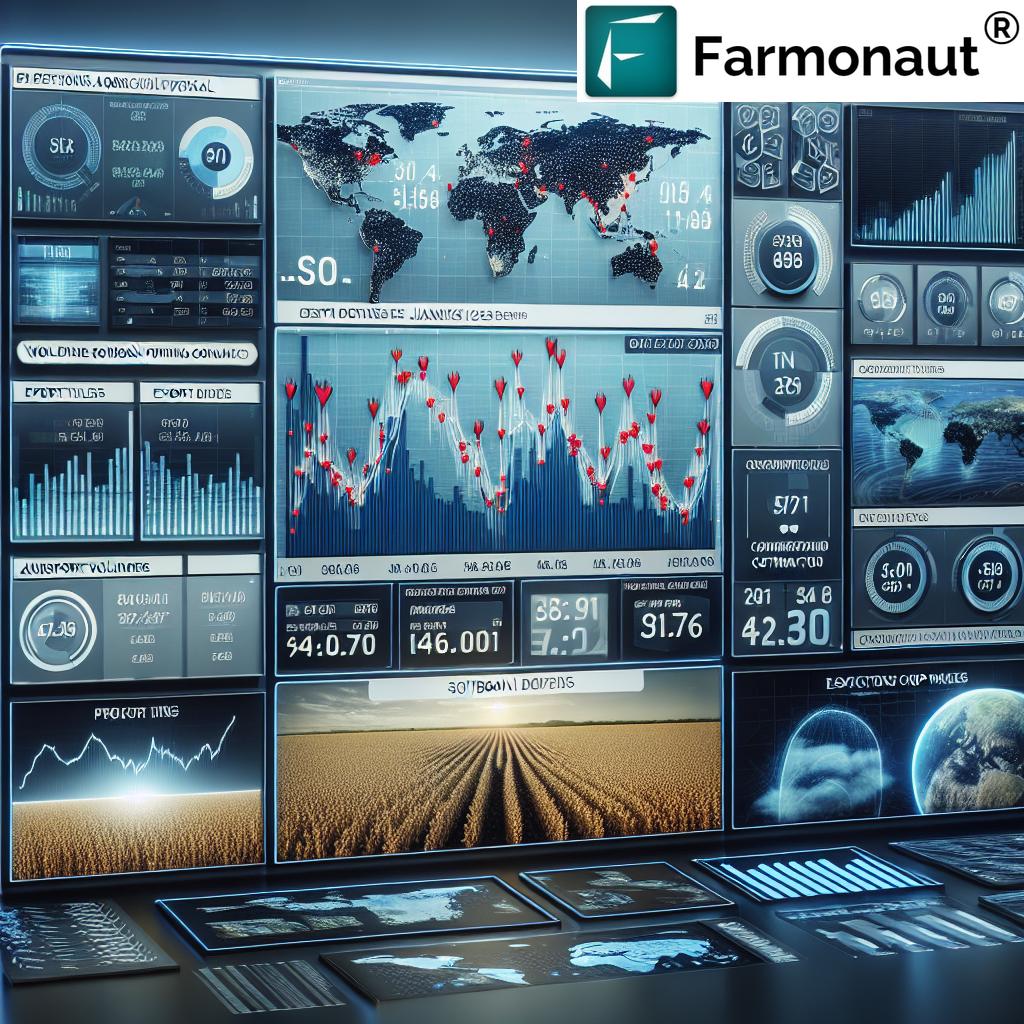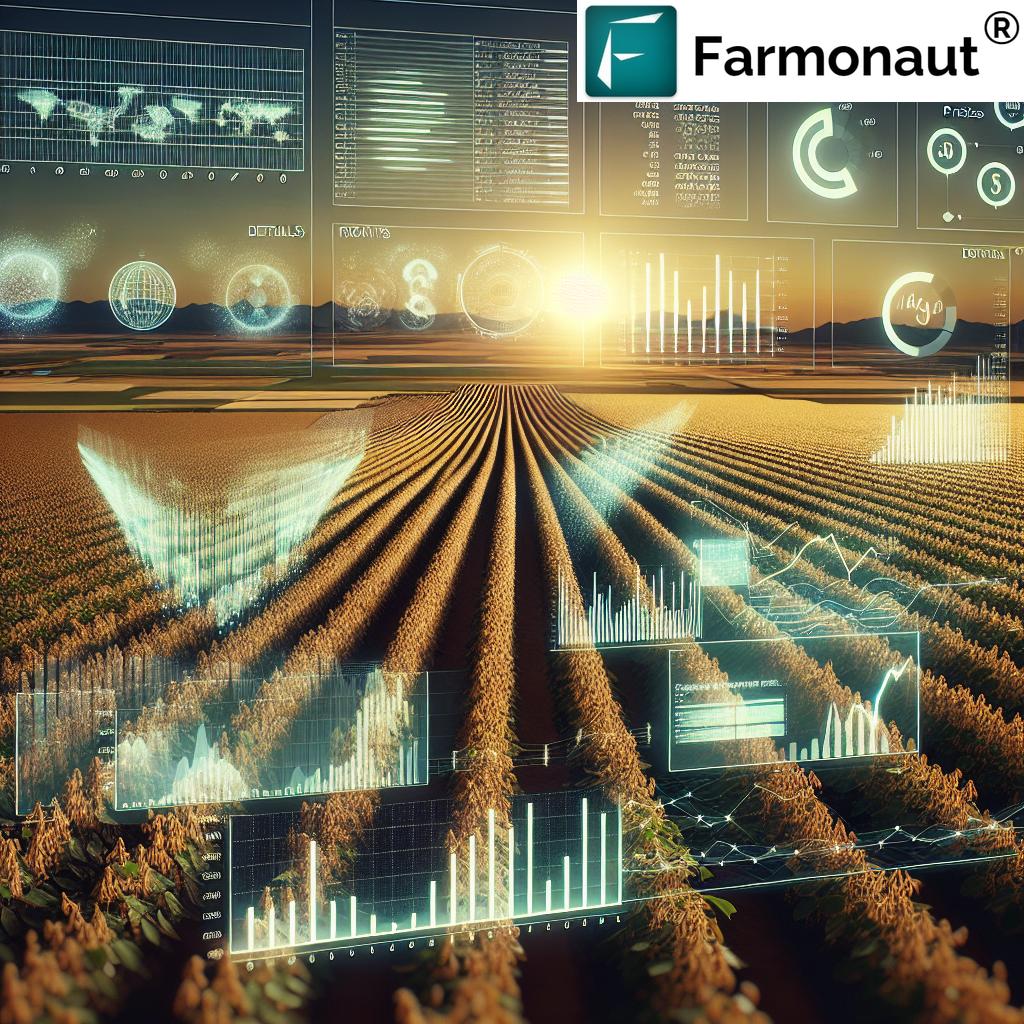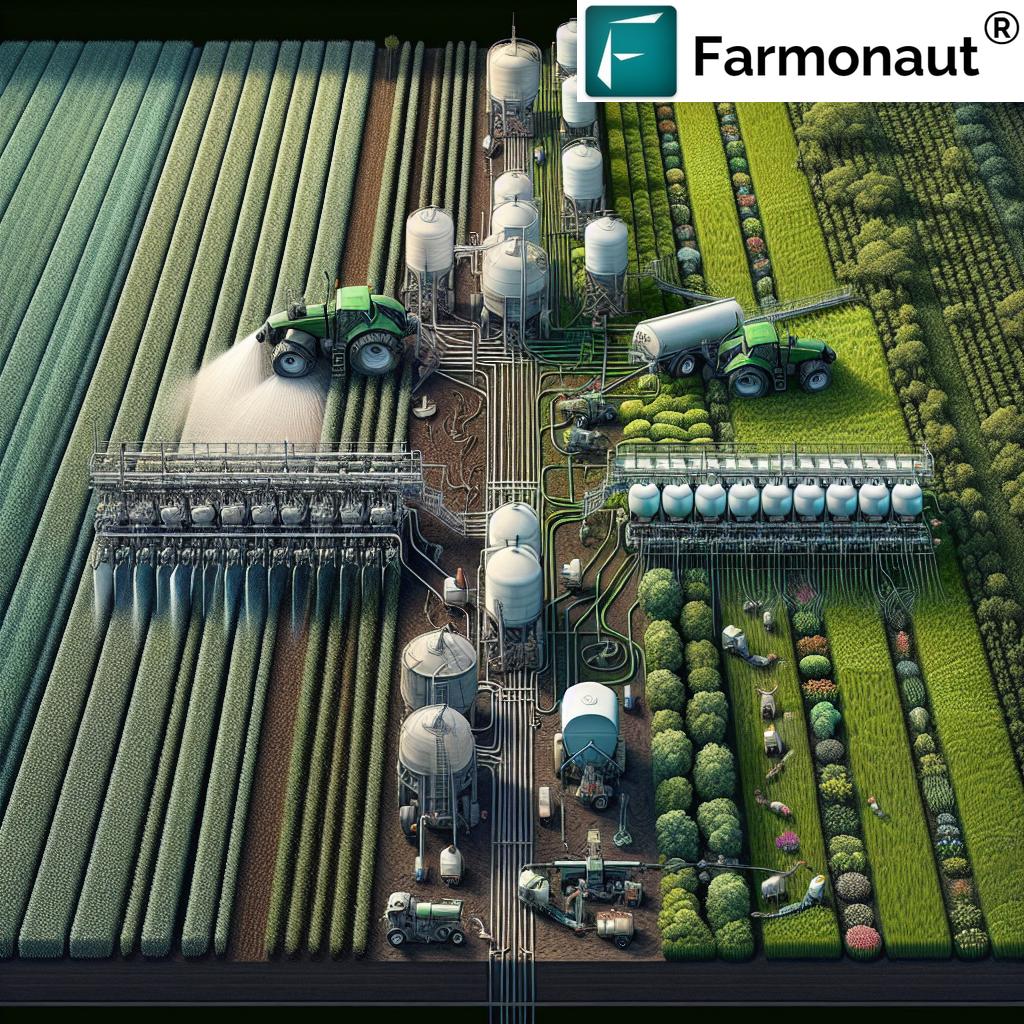Soybean Futures Market Analysis: Key Trends and Strategies for January 2025 Contract
“Soybean futures for January 2025 contract experienced recent price declines, with weekly drops observed in the market.”
Welcome to Farmonaut’s comprehensive analysis of the soybean futures market, focusing on the January 2025 contract. As leaders in agricultural technology and market intelligence, we’re here to provide you with valuable insights into commodity price trends, agricultural market insights, and futures trading strategies. Our goal is to equip traders, analysts, and industry professionals with the knowledge needed to navigate the dynamic world of agritech and commodity markets.
Understanding the Soybean Futures Market
The soybean futures market is a critical component of the global agricultural commodities sector. As we delve into the analysis of the January 2025 contract, it’s essential to understand the factors driving market performance and price fluctuations. Let’s begin by examining the current state of the market and recent trends.

Market Overview and Recent Performance
The January 2025 soybean futures contract has experienced notable price declines in recent weeks. This downward trend has caught the attention of market participants and analysts alike. To provide a clear picture of the current market situation, we’ve compiled a comprehensive overview in the table below:
| Contract Specification | Current Price | Weekly Change (%) | Monthly Change (%) | Open Interest | Trading Volume | Managed Money Net Position | Export Data (bushels) |
|---|---|---|---|---|---|---|---|
| January 2025 Soybean Futures | $12.15 per bushel | -2.3% | -5.7% | 187,500 contracts | 45,000 daily average | Net long 75,000 contracts | 125 million |
Key market factors influencing soybean futures:
- Weather conditions in major soybean-producing regions
- Global supply and demand dynamics
- Trade policies and international relations
- Currency fluctuations, particularly the U.S. dollar
- Biofuel industry demand
Analyzing Price Trends and Market Signals
To gain a deeper understanding of the soybean futures market, we need to examine the underlying factors contributing to recent price declines and weekly drops. Our analysis incorporates a range of data points and market indicators to provide a comprehensive view of the current landscape.
Supply and Demand Dynamics
One of the primary drivers of soybean futures prices is the delicate balance between supply and demand. Recent reports indicate an increase in global soybean production, particularly in key growing regions such as the United States, Brazil, and Argentina. This abundant supply has put downward pressure on prices, contributing to the observed declines in the January 2025 contract.
On the demand side, we’ve seen fluctuations in major importing countries, with China’s purchasing patterns playing a significant role in market movements. The ongoing trade negotiations and policies have added an element of uncertainty to the demand outlook, further influencing price volatility.
Weather Patterns and Crop Conditions
Weather conditions in major soybean-producing regions have a substantial impact on futures prices. Our satellite-based crop monitoring technology at Farmonaut allows us to track crop health and predict potential yield issues with unprecedented accuracy. Recent data suggests favorable growing conditions in key areas, which has contributed to the bearish sentiment in the market.
To get real-time insights into crop conditions and weather patterns, consider using our advanced satellite monitoring tools:
Technical Analysis and Chart Patterns
Technical traders closely monitor chart patterns and indicators to identify potential trading opportunities. The recent price action in the January 2025 soybean futures contract has formed some interesting technical setups:
- A descending triangle pattern on the daily chart, suggesting potential further downside
- The 50-day moving average crossing below the 200-day moving average, forming a bearish “death cross”
- Relative Strength Index (RSI) indicating oversold conditions, which may lead to a short-term bounce
These technical factors, combined with fundamental analysis, provide valuable insights for traders developing their futures trading strategies.
Commodity Export Data and Global Trade Flows
Understanding commodity export data is crucial for predicting future price movements in the soybean futures market. Our analysis of recent export figures reveals some interesting trends:
- U.S. soybean exports have seen a slight decline in recent months, partly due to increased competition from South American producers
- Brazil has reported record-breaking soybean exports, capitalizing on favorable exchange rates and strong demand from China
- Argentina’s exports have been impacted by domestic economic policies and weather-related challenges
These global trade flows play a significant role in shaping the supply and demand dynamics of the soybean market, ultimately influencing futures prices.
Managed Money Positions and Market Sentiment
“Shifts in managed money positions and export data significantly influence soybean futures market trends and price forecasts.”
The positions held by managed money, including hedge funds and other large speculators, can provide valuable insights into market sentiment and potential price directions. Our analysis of recent Commitments of Traders (COT) reports shows:
- A reduction in net long positions held by managed money
- Increased short positions, indicating a more bearish outlook among large speculators
- Overall decrease in open interest, suggesting some market participants are moving to the sidelines
These shifts in managed money positions often precede significant price movements, making them an essential factor to consider in your soybean futures market analysis.
Precision Agriculture Solutions and Market Intelligence
At Farmonaut, we believe that precision agriculture solutions play a crucial role in shaping market intelligence and informing trading decisions. Our advanced satellite-based farm management tools provide unparalleled insights into crop conditions, soil moisture levels, and potential yield issues.

By leveraging these technologies, traders and analysts can gain a competitive edge in predicting market movements and developing effective futures trading strategies. Some key benefits of our precision agriculture solutions include:
- Real-time crop health monitoring using multispectral satellite imagery
- AI-driven advisory systems for optimized crop management
- Blockchain-based traceability for enhanced supply chain transparency
- Advanced weather forecasting and climate modeling
To explore how our precision agriculture solutions can enhance your market intelligence:
Strategies for Trading the January 2025 Soybean Futures Contract
Given the current market conditions and our comprehensive analysis, we’ve identified several strategies that traders may consider for the January 2025 soybean futures contract:
- Spread Trading: Consider trading the spread between different soybean futures contracts or between soybeans and other related commodities like corn or wheat. This strategy can help mitigate some of the directional risk associated with outright futures positions.
- Options Strategies: Implement options strategies such as straddles or strangles to capitalize on potential volatility without taking a directional view on the market.
- Scale-In Approach: For traders with a longer-term bullish outlook, the current price declines may present opportunities to scale into long positions at favorable levels.
- Technical Breakout Trading: Monitor key support and resistance levels for potential breakout opportunities, using technical indicators to confirm trend changes.
- Fundamental-Driven Trading: Stay attuned to key fundamental factors such as weather events, export data, and USDA reports to inform your trading decisions.
Remember, each of these strategies carries its own set of risks and potential rewards. It’s crucial to thoroughly understand the market dynamics and your own risk tolerance before implementing any trading strategy.
Crop Price Forecasting and Global Agricultural Trends
Accurate crop price forecasting is essential for developing effective futures trading strategies. At Farmonaut, we combine advanced satellite imagery, machine learning algorithms, and expert analysis to provide reliable price forecasts for soybeans and other major crops.
Some key global agricultural trends influencing soybean prices include:
- Increasing demand for plant-based proteins in developed markets
- Expansion of soybean cultivation in non-traditional growing regions
- Adoption of genetically modified soybean varieties to improve yield and resistance
- Growing emphasis on sustainable and organic farming practices
- Climate change impacts on traditional growing regions and crop yields
By staying informed about these trends and leveraging our advanced crop monitoring tools, traders can make more informed decisions in the soybean futures market.
The Role of Agritech in Commodity Markets
The integration of advanced technology in agriculture, or agritech, is revolutionizing how we analyze and trade commodity markets. Farmonaut’s suite of tools exemplifies this transformation, offering unprecedented insights into crop conditions, yield forecasts, and market trends.
Key ways agritech is shaping commodity markets:
- Improved accuracy in crop yield predictions
- Real-time monitoring of growing conditions and potential issues
- Enhanced supply chain transparency through blockchain technology
- More efficient resource allocation and reduced waste in agriculture
- Data-driven decision making for farmers, traders, and policymakers
To explore how our agritech solutions can enhance your market analysis and trading strategies, visit our API documentation:
Conclusion: Navigating the Soybean Futures Market in 2025
As we look ahead to the January 2025 soybean futures contract, it’s clear that a combination of fundamental analysis, technical trading strategies, and cutting-edge agritech solutions will be crucial for success in this dynamic market. The recent price declines and shifts in managed money positions highlight the importance of staying informed and adaptable in your trading approach.
By leveraging Farmonaut’s precision agriculture solutions and market intelligence tools, traders and analysts can gain a competitive edge in predicting market movements and developing effective futures trading strategies. Our satellite-based crop monitoring, AI-driven advisory systems, and blockchain traceability solutions provide unparalleled insights into the factors driving soybean prices and global agricultural trends.
As you navigate the complexities of the soybean futures market, remember to stay informed about key factors such as weather patterns, global trade flows, and shifts in supply and demand dynamics. By combining these insights with robust technical analysis and a deep understanding of market sentiment, you’ll be well-equipped to make informed decisions and capitalize on opportunities in the ever-evolving world of commodity trading.
FAQ Section
Q: What are the key factors influencing soybean futures prices?
A: The main factors include weather conditions in major growing regions, global supply and demand dynamics, trade policies, currency fluctuations, and biofuel industry demand.
Q: How can Farmonaut’s precision agriculture solutions help in soybean futures trading?
A: Our solutions provide real-time crop health monitoring, AI-driven advisory systems, and blockchain-based traceability, offering valuable insights for more informed trading decisions.
Q: What strategies can be employed for trading the January 2025 soybean futures contract?
A: Some strategies include spread trading, options strategies, scale-in approaches, technical breakout trading, and fundamental-driven trading based on key market factors.
Q: How does agritech impact commodity markets?
A: Agritech improves crop yield predictions, enables real-time monitoring of growing conditions, enhances supply chain transparency, and facilitates data-driven decision making in agriculture and trading.
Q: Where can I access Farmonaut’s agricultural market intelligence tools?
A: You can access our tools through our web application, mobile apps for Android and iOS, and our API for developers. Links to these resources are provided throughout this article.
Stay ahead in the soybean futures market with Farmonaut’s comprehensive suite of agricultural technology solutions. Our tools empower traders, analysts, and industry professionals with the insights needed to navigate the complex world of commodity markets. Explore our offerings today and revolutionize your approach to agricultural market analysis.












